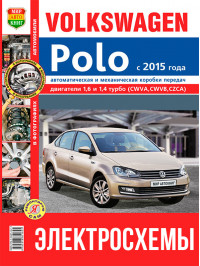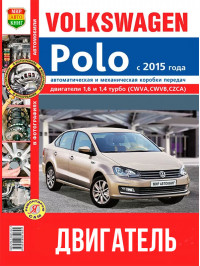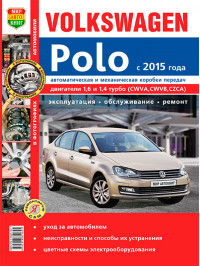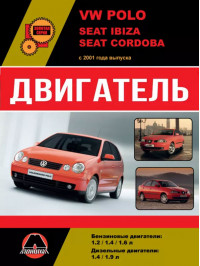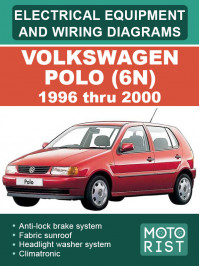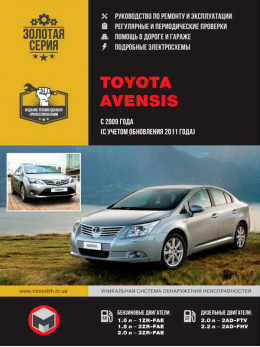Information on repair and maintenance of Volkswagen Polo cars electronically
Volkswagen Polo is a subcompact car from Volkswagen, the name of which comes from the sport of the same name. It was introduced in 1975, and the sixth series of the car was released in 2017.
Throughout its history, it has been sold with the bodies of three- and five-door hatchbacks, two- and four-door sedans and five-door station wagons. Five-seater model with a transverse front engine and front-wheel drive.
Characteristics of Volkswagen Polo
Some of its sister models within the Volkswagen Group are the Skoda Fabia, SEAT Ibiza and Audi A1. Volkswagen sold the SEAT Cordoba under the names VW Polo Classic or VW Polo Variant with a different front and rear design.
Over the entire period of production, VW Polo has been produced for six generations:
- Volkswagen Polo I (from 1975 to 1981);
- Volkswagen Polo II (from 1981 to 1994);
- Volkswagen Polo III (from 1994 to 2001);
- Volkswagen Polo IV (from 2001 to 2009);
- Volkswagen Polo V (from 2009 to 2017);
- Volkswagen Polo VI (2017 to present)
It was originally a stricter version of the slightly better equipped Audi 50, which was discontinued in mid-1978. The first generation VW Polo was offered with a three-door hatchback and a two-door sedan (Volkswagen Derby).
The gearboxes were four-speed manual. All engines were in-line four-cylinder water-cooled gasoline engines:
- 0.8-liter 34 hp;
- 0.9-liter 40 hp;
- 1.1-liter with 50 or 60 hp;
- 1.3-liter 60 hp
The second generation VW Polo was presented in two three-door hatchback variants, one with the rear window down and the other with a fully vertical window. The two-door sedan variant ceased to be called VW Derby in 1985 and received other names such as VW Polo Sedan or VW Polo Classic.
The third generation VW Polo was offered with bodies of three - and five-door hatchback, four-door sedan and five-door station wagon VW Polo Variant, the latter two descended from the first generation SEAT Cordoba. The van version is sold under the name Volkswagen Caddy. Volkswagen Lupo and SEAT Arosa used a shortened version of the VW Polo III platform.
The fourth generation VW Polo shares its platform with the third generation SEAT Ibiza and the Skoda Fabia. The station wagon body was abandoned, so three and five-door hatchbacks and a four-door sedan remain on sale.
On the model before restyling in May 2005, the VW Polo had four round headlights, similar to those of the VW Lupo. Later they were replaced with a format closer to the late 2000s models, which are more similar to the VW Passat B6.
The fifth generation VW Polo was originally presented with a five-door hatchback as well as a sportier three-door body. The chassis is the same as that of the SEAT Ibiza IV, Skoda Fabia II and the first generation Audi A1. This new VW Polo has increased its dimensions compared to its predecessor, now with an overall length of 3,970 mm, an overall width of 1,682 mm, an overall height of 1,485 mm and a wheelbase of 2,470 mm.
The sixth generation VW Polo debuted globally on June 16, 2017. An off-road version called the VW T-Cross has also been produced since 2019.
The VW Polo VI is upscaling again as it uses the new MQB A0 platform, which also gives life to the SEAT Ibiza V and Audi A1 GB. Now its length is 4.05 m, width - 1.75 m, height - 1.45 m, and the volume of the trunk is 351 liters.
No car is insured against breakdowns, and Volkswagen Polo repair, sooner or later, is inevitable. Any car repair has its own specific features.
Volkswagen Polo service manual
Before you start repairing a car yourself, without the help of a specialist, you must have an initial basic knowledge of its structure. To master this knowledge, you will need patience, time and a special manual for the repair and operation of the car.
On our website, you can read a book on Volkswagen Polo repair in electronic form absolutely free of charge and, after making sure of the quality of the information presented, buy a book in PDF format.
The Volkswagen Polo car repair manual describes in detail the design of the car, the main characteristics of the car systems, illustrations with a detailed description of the repair work. The information is presented as simply as possible, accessible and understandable to everyone.









